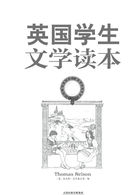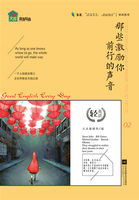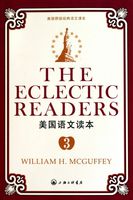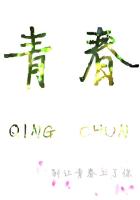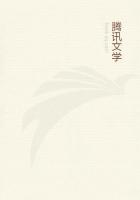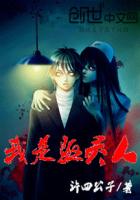A striking example of this is the compass plant, the leaves of which arrange themselves so that the sun"s rays strike the broad surface of the leaves at night and morning when the rays are not very strong, but at noon the edge of the leaf is toward the sun, the leaf thus maintaining a nearly vertical position all day, with its greatest length extending in a nearly north and south line. It is the effort toregulate the amount of light falling on the leaf, and not any magnetic influence, which causes the leaf to point in the direction of the compass needle.
The shapes of the leaves vary greatly in different plants. Sometimes they assume very singular forms, as in the pitcher plant (Fig. 92) and Jack-in-the-pulpit. Sometimes they even become carnivorous,as in the sundew and Venus flytrap.
Fig. 92.
Fig. 93.
Around the margin of the sundew leaf and on the inner surface are a number of short bristles each having at the end a knob which secretes a sticky liquid. As soon as an insect touches one of these knobs, it sticks to the knob and the other bristles begin to close in upon the insect and hold it fast. Soon the insect dies and the leaf secretes a juice which digests its soluble parts. In the Venus flytrap (Fig. 93) the leaf terminates in a portion which is hinged at the middle and has on the inside of eachhalf three short hairs, while the outside is fringed by stiff bristles. As soon as an insect touches the hairs, the trap closes rapidly upon it and stays closed until it is digested, when the trap again opens. Carnivorous plants of this kind usually grow in places where it is difficult to get nitrogenous foods, and may have adopted this way to supply the need.
Some leaves extend themselves into spiny points, like the thistle (Fig. 94), in order to keep animals from destroying the plant, or they may develop a sharp cutting edge, like some grasses, or emit a bad odor, or have a repugnant bitter taste.
The veins or little ridges extending through the leaf from the leaf stem vary(Fig. 95.) Sometimes these
Fig. 94.
veins extend parallel to
each other through the leaf, as in the corn and palm. This is generally characteristic of monocotyledonous leaves. In other leaves, the veins form a network, as in the maple and apple. This is characteristic of dicotyledonous plants.
Fig. 95.
Experiment 99. -Place the freshly cut stem of a white rose, white carnation, variegated geranium leaf, or any thrifty leaf which is somewhat transparent, in a beaker containing slightly warmed water strongly colored with eosin. Allow it to remain for some time. The coloring matter can be seen to have passed up the stem and spread through the leaf or flower.
The great function of the leaf is to manufacture plant foods. The leaf is so constructed that air can enter it and come in contact with its living cells, as does the water coming up from its roots. The circulation of water in the leaf was seen in Experiment 99. There is in the living cell of the leaf a green substance called chlorophyll. This has the power to utilize the energy of sunlight and to combine carbon dioxide, a gas which makes up a small part of the air, with water from the roots,forming a substance which probably at first is grape sugar, but whichin many leaves is changed at once into starch.
Experiment 100. -Boil a few fresh bean or geranium leaves for a few minutes in a beaker of water. Pour off the water and pour on enough alcohol to cover the leaves. Warm the alcohol by putting the beaker in a dish of hot water. When the leaves have become colorless, remove from the alcohol and wash. Place the leaves in another beaker and pour on a solution of iodine. (This solution can be made by dissolving in 500 cc. of water, 2 grams of potassium iodide and 1/2 gram of iodine. The solution should be bottled and kept.) If the leaves turn dark blue or blackish, starch is present.
Experiment 101. -Place a thrifty geranium or other green plant in darkness for two or three days and then treat the leaves as was done in Experiment 100. Do they show the presence of starch? The direct Presence of the sun"s energy in the form of light is necessary for the formation of starch in the leaves.
It was found in Experiment 100 that leaves exposed to the sun contained starch, and in Experiment 101 that leaves which had been deprived of sunlight did not have starch. The starch disappeared while the plant was in darkness. Carbon dioxide is composed of carbon and oxygen; and water of hydrogen and oxygen. In the manufacture of starch by the chlorophyll some of the oxygen is not used and becomes a waste product which the leaves throw off. This is seen in Experiment 102.
Experiment 102. -Under an inverted funnel in a battery jar, place some pond scum or hornwort. Fill the jar with fresh water and over the neck of the funnel place an inverted test tube filled with water. When placed in the sunlight, bubbles of oxygen will rise into the test tube and collect. The oxygen can be tested by turning the test tube right side up and quickly inserting a glowing splinter.
If the splinter bursts into a flame, oxygen is present. (Afreshly picked leaf covered with water and put in theFig. 96.
sunlight will be seen to give off these bubbles.) After a small amount of gas has been collected in the test tube, mark the height of the water column and place the battery jar in the dark, allowing it to remain there for ten or twelve hours. No oxygen is given off in the dark. Place the jar in the light again. Oxygen is given off. Is the sun"s energy needed to enable the plant to give off oxygen?
The starch manufactured is insoluble in water and is stored in the leaf during the day. But at night, when the leaf is not manufacturing starch, it is able to digest the starch by means of a special substance, leaf diastase, which it forms. This changes it into sugar, which is soluble and which flows to other parts of the plant. Compounds such as starch and sugar, in which there is only carbon, hydrogen and oxygen, are called carbohydrates.

